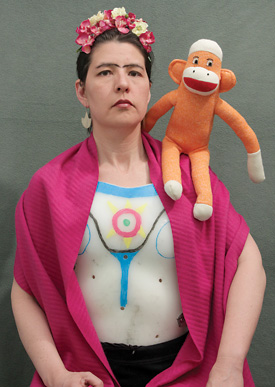What moment in the classroom stands out as the most memorable?
I was teaching a class on time-based art forms (installation, sound art, performance) and several students from Japan who spoke no English ended up making and presenting amazing art for their final project. It was an incredible testament to the power of visual images to communicate complex ideas without written or verbal language.
What can’t you live without?
A camera. As an artist, it’s my tool for looking at the world in a creative and open way.
What is your favorite spot in Ann Arbor?
Bandemer Park, with its canoe livery and bike and walking paths and Frisbee golf course. It’s a great place to walk my dog and see the natural side of Ann Arbor.
What inspires you?
Stories with emotional and psychological weight. Historical and contemporary stories of survival.
What are you currently reading?
Walter Murch’s “In the Blink of an Eye,” an incisive series of essays about editing sound for films and the importance of maintaining an emotional connection with the viewer.
Who had the greatest influence on your career path?
Professor Harvey Himelfarb, my undergraduate photography professor at the University of California, Davis. When I took my first art class with him I was a chemistry major. He transformed my whole view of the world, showing me that it was possible to make a life and career as an artist.
A glass bell jar, a projector, several video clips, and a blank prisoner’s identification tag make up one of Heidi Kumao’s art pieces, “Transplant,” about the Japanese internment in War Relocation Centers in California during World War II.
Kumao’s image theater sculptures reveal true stories of the creative outlets prisoners have used to maintain their humanity. Kumao’s alchemy transforms ordinary objects that are trapped within bell jars, with projected video imagery.
In “Transplant” she retells the story of American citizens of Japanese ancestory that were confined in war relocation centers during WWII. Suspended inside the bell jar, a blank prisoner’s ID tag alternately becomes the face of an interned Japanese American girl, a discarded pan of dust, a guard tower, the American flag and a sprouting seedling. The shadow of the tag is worked into background imagery as her narrative unfolds through sculpted video composition and archival images of the California desert internment camps.
Kumao, an associate professor of art at the Stamps School of Art & Design, was inspired to create the piece when reading about the elaborate desert gardens that Japanese prisoners created while in the camps. “I need a problem to solve,” says Kumao of her inspiration process. “I need a strong emotional connection first, then I need to do research.”
Kumao says that her “Timed Release” pieces allow viewers to “fluctuate between two perceptions of the same tableau,” which then leads them to identify with the prisoner’s challenge to “balance hopelessness and creativity.” She received a Guggenheim Fellowship for this work.
Much of Kumao’s work is interactive in some way, and she describes her art as being “at the intersection of theater, technology and psychology.” She has a large database of video clips and photographs that she has collected over many years and uses in her various video and projection projects.

“Self-portrait with monkey (Frida),” 2011; from a series of self-portraits made during Heidi Kumao’s recovery from a broken back. Photo by Heidi Kumao.
“Making art is optimizing the chance for good accidents,” says Kumao, who refers to many of her works-in-progress as “experiments.” She stresses this to her students as well. Kumao teaches one lower level and one upper level class every semester, as well as mentors graduate students, and then spends the rest of her time preparing for exhibitions, producing new work, and applying for grants.
When not in her studio or the classroom, Kumao enjoys gardening, swimming, and crafting. She upcycles wool and cashmere sweaters from thrift stores into quilts and other things, and sculpts little creatures with felted raw wool.
The weekly Spotlight features faculty and staff members at the university. To nominate a candidate, please contact the Record staff at [email protected].

